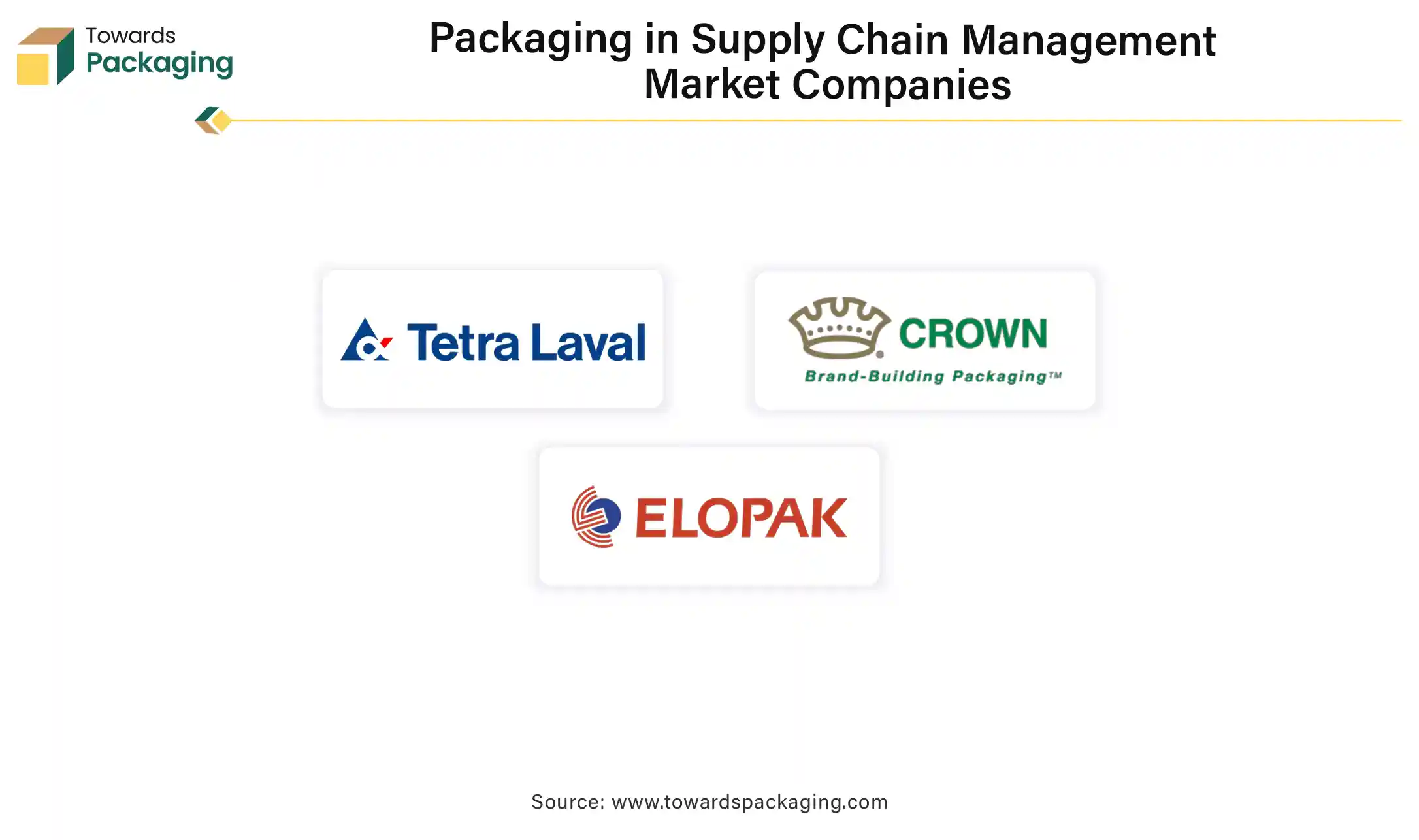March 2025
.webp)
Principal Consultant

Reviewed By
The packaging in supply chain management market is experiencing rapid evolution with the integration of QR codes in marketing functions, making tracking and authentication more efficient. The key players operating in the market are focused on adopting inorganic growth strategies like acquisition and merger to develop advance technology for manufacturing packaging in supply chain management which is estimated to drive the global packaging in supply chain management market over the forecast period.
Packaging industry supply chain management refers to the coordinated process of designing, producing, and delivering packaging materials efficiently. It involves managing the flow of raw materials, production, storage, and distribution to ensure packaging meets quality, cost, and sustainability goals. The packaging in supply chain management ensures the raw material transportation as per regulatory and industry standards.
Governments worldwide are enacting stricter regulations on packaging materials to promote sustainability. Companies must navigate these evolving regulations by adopting circular economy principles, such as reuse and recycling, to meet compliance requirements and avoid penalties. The increasing complexity of global supply chains necessitates agile strategies that can swiftly adapt to disruptions and changing market demands. Companies are implementing flexible production plans and diversifying supplier networks to maintain resilience and ensure continuity in their operations.
Environmental concerns are prompting companies to adopt eco-friendly packaging solutions. This shift involves using biodegradable, compostable, and recyclable materials, as well as reducing packaging waste through minimalist designs. For instance, the global flexible packaging market is projected to approach USD 400 billion by 2029, reflecting a growing preference for sustainable options.
Technological innovations are leading to the adoption of smart packaging equipped with features like QR codes, NFC tags, and augmented reality. These enhancements improve consumer engagement, provide product authentication, and offer real-time tracking, thereby increasing transparency and trust in the supply chain.
AI and automation are revolutionizing supply chain operations by enabling predictive maintenance, optimizing inventory management, and enhancing demand forecasting. Manufacturers are leveraging AI to analyze sensor data and usage patterns, facilitating proactive decision-making and reducing operational disruptions.
Consumers and regulators are demanding greater visibility into product origins and supply chain practices. Implementing advanced tracking systems and transparent reporting mechanisms helps build consumer trust and ensures compliance with regulatory standards.
Supply chain planning, production, management, and optimization may all be completely transformed by implementing artificial intelligence (AI). AI can enhance operational efficiency and supply chain decision-making by processing enormous volumes of data, identifying patterns, and carrying out intricate operations in real time. This technology has becoming more well-known recently as new developments like generative Al and chatbots have gained traction and demonstrated the systems' potential benefits for supply chain management.
AI-powered supply chain systems are assisting businesses with route optimization, workflow optimization, procurement enhancement, shortfall reduction, and end-to-end task automation. Particularly for businesses who frequently depend on their partners to ship their goods in a timely and organized manner, a supply chain can become complex. In contrast to a conventional non-AI system, AI's capacity to identify patterns and linkages allows it to maintain equilibrium across all components of a supply chain. From the warehouse to the cargo freighters to the distribution centers, these patterns can aid in the optimization of logistics networks.
The expansion of e-commerce requires durable, lightweight, and cost-effective packaging solutions. Companies invest in protective and smart packaging to reduce damage and enhance the unboxing experience.
The key players operating in the packaging ins supply chain management market face issues due to supply chain disruption and stringent regulatory requirements, which has restricted the growth of the market. Compliance with environmental and safety standards can necessitate additional investments in technology and materials, potentially slowing down growth. Global uncertainties, such as trade tensions or logistical interruptions, can affect material supply and distribution efficiency, impacting overall market growth. Fluctuations in the prices of essential materials (like paper, plastic, and metals) can increase production costs and squeeze margins.
Smart packaging with RFID, QR codes, and NFC enables better product tracking and inventory management. AI and automation in packaging manufacturing enhance efficiency and reduce costs. 3D printing allows for rapid prototyping and customization. Lightweight packaging materials help reduce transportation costs and improve logistics efficiency. Automated packaging solutions improve speed, accuracy, and labor efficiency in the supply chain.
The QR codes segment held a dominant presence in the packaging in supply chain management market in 2024. QR codes can be quickly scanned with smartphones or dedicated devices, which speeds up processes like inventory checks and shipment tracking. Automated scanning minimizes human errors compared to manual data entry, ensuring more accurate record-keeping. They provide detailed information about the product's journey through the supply chain from manufacturing to delivery enhancing traceability. QR codes can easily be integrated into digital supply chain management systems, allowing real-time updates and monitoring. Generating and printing QR codes is inexpensive, making them a cost-effective solution for businesses of all sizes.
The manufacturers segment accounted for a significant share of the market in 2024. Manufacturers convert raw materials into value-added products, forming the critical link between suppliers and the market. They adapt production processes to meet evolving market demands and drive innovation in product design and functionality. Manufacturers often operate at a scale that reduces per-unit costs, making products more competitive in the market. Manufacturers implement quality control measures to ensure that products meet industry and regulatory standards, which is crucial for maintaining consumer trust. Manufacturers often collaborate closely with suppliers, distributors, and retailers to synchronize production schedules, manage inventory, and ensure timely delivery.
The recycled segment led the global packaging in supply chain management market. Recyclable packaging minimizes the amount of waste that ends up in landfills, contributing to a reduction in environmental pollution. Many regions have introduced laws and regulations that require or incentivize the use of sustainable, recyclable materials. This drives manufacturers and supply chain partners to adopt recyclable packaging to meet compliance standards. Global trade often necessitates adherence to stringent environmental standards, pushing companies toward recyclable packaging solutions. Recyclable materials often lead to lower disposal costs and, in some cases, can be reprocessed into new products, offering long-term savings. Recyclable packaging supports a circular economy model, which can lead to cost savings through resource reuse and reduced dependency on virgin materials.
The food & beverages segment dominated the packaging in supply chain management market globally. Packaging for food and beverages must adhere to stringent safety and hygiene regulations. This ensures that products remain uncontaminated throughout the supply chain. Food and beverage products typically experience high turnover rates. Efficient packaging supply chain management is crucial to support the fast pace of production and distribution.
The food and beverage industry relies on complex, often global supply chains. Robust packaging ensures products withstand transportation, handling, and storage conditions. As consumers become more environmentally conscious, there is increased pressure on food and beverage companies to adopt sustainable packaging practices. This trend drives innovation in recyclable and biodegradable packaging materials.
Asia Pacific region dominated the global packaging in supplying chain management market in 2024. Asia Pacific region is home to some of the world's largest manufacturing hubs, which enable high-volume production of packaging materials and innovative packaging solutions. Many Asia Pacific countries are key exporters, benefiting from well-established supply chains that link domestic production with global markets.
China’s Packaging in Supply Chain Trends
China packaging in supply chain management market has estimated to grow at rapid rate due to expanding E-commerce platform in the region. A booming e-commerce market has increased the demand for innovative, durable, and customizable packaging solutions that ensure product safety and enhance consumer experience. China’s extensive manufacturing infrastructure enables large-scale production at competitive costs, ensuring a steady supply of packaging materials and solutions. The ability to produce vast quantities efficiently lowers unit costs, making it attractive for both domestic and international markets. China’s well-integrated supply chain networks and strategic global trade position make it a key player in international packaging markets.
North America region is anticipated to grow at the fastest rate in the packaging in supply chain management market during the forecast period. Large import/export capital in North America fuels the packaging supply chain management market by driving higher demand, enabling significant investments in technology and infrastructure, and fostering an environment where innovation and efficiency can thrive. Significant capital facilitates adherence to stringent international quality and safety standards, enabling North American companies to compete more effectively on the global stage.
U.S. Packaging in Supply Chain Trends
U.S. companies are investing in smart packaging solutions and digital tracking technologies such as IoT, RFID, and blockchain, which enhance traceability, efficiency, and data-driven decision-making. U.S. regulatory frameworks require adherence to strict safety, environmental, and quality standards. This drives companies to adopt advanced, reliable packaging systems that meet these requirements. The rapid growth of online retail in the U.S. increases the need for packaging that not only protects products during transit but also enhances the unboxing experience.
Europe is seen to grow at a notable rate in the foreseeable future. Strict European Union regulations on waste reduction and recycling drive the adoption of sustainable, recyclable, and biodegradable packaging materials. Europe's well-developed transportation networks and logistics infrastructure ensure smooth and reliable movement of goods across domestic and international markets. European packaging companies adhere to rigorous quality, safety, and environmental standards, which not only protect consumers but also bolster brand reputation.

By Marketing Function
By Flow Function
By Environment
By End Users
By Region
March 2025
March 2025
March 2025
March 2025